Decorative patterns on painted portery of the Yangshao culture
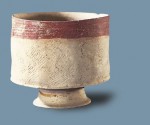 Painted pottery of the Yangshao culture is recognized as the most representative of the prehistory painted pottery found in China.
Painted pottery of the Yangshao culture is recognized as the most representative of the prehistory painted pottery found in China.
Back in 1921, ruins of a primitive village were found at Yangshao Village, Mianchi County, Henan Province, which was to be identified as belonging to a highly developed matriarchal society existed in central China.
Many cultural relics have been unearthed from the site since then. Included are pottery utensils for daily use, which are valued not only for their cultural importance but also for the workmanship with which they were produced. Earth to be used for making the roughcasts with was rinsed and, for that, most products are of the same color as their roughcasts. To be more precise, products produced with roughcasts of fine mud are red, and those produced with roughcasts of fine mud mixed with fine grains of sand are brownish red.
Most decorative patterns were painted in black, and the rest in red. 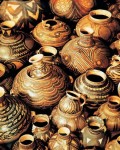 Sometimes a thin layer of red or white coating was applied to the roughcasts, on which decorative patterns were then painted, in order to ensure a greater contrast of the colors.
Sometimes a thin layer of red or white coating was applied to the roughcasts, on which decorative patterns were then painted, in order to ensure a greater contrast of the colors.
The Yangshao culture dates back to a period from 5,000 years BC to 3,000 years BC. Primitive sites and ruins found later in other parts of central China are culturally similar to the Yangshao ruins. For that, the Yangshao culture has been recognized as synonym of the culture prevalent in central China during the matriarchal clan society – in a region with Gansu, Shaanxi and Henan as center while encompassing Hebei, Inner Mongolia, Shanxi, Qinghai, as well as parts of Hubei.
Intriguing Facial Makeup
 Seeing a Peking Opera performance for the first time, a foreigner would wonder: why are faces of actors painted red, white, black, yellow or green? Are they masks? But masks are separate from the face. Facial makeups in Peking Opera are different from masks. Intrigued, many foreign tourists would go backstage to see actors and actresses remove stage makeup and costume. Next time, they would go there before a performance starts to see how performers do their makeup. Luciano Pararotti, the great tenor of international fame, once had a Peking Opera actor paint on his face the makeup of Xiang Yu, a valiant ancient warrior portrayed in numerous Peking Opera plays.
Seeing a Peking Opera performance for the first time, a foreigner would wonder: why are faces of actors painted red, white, black, yellow or green? Are they masks? But masks are separate from the face. Facial makeups in Peking Opera are different from masks. Intrigued, many foreign tourists would go backstage to see actors and actresses remove stage makeup and costume. Next time, they would go there before a performance starts to see how performers do their makeup. Luciano Pararotti, the great tenor of international fame, once had a Peking Opera actor paint on his face the makeup of Xiang Yu, a valiant ancient warrior portrayed in numerous Peking Opera plays.
The facial makeup is a unique way of portrayal in the traditional Chinese theater. Makeup types number thousands, and different types have different meanings. At an early date, most faces were painted black, red and white. As plays increase in number, opera artists used more colors and lines to paint the faces of characters, to either exaggerate or differentiate, according to Weng Ouhong, a researcher of the classic Chinese theater. They drew inspirations from classical novels, which portray characters as having “a face as red as a red jujube,” “a face the color of dark gold,” ”a ginger-yellow face,” “a green face with yellow beard,” “a leopard-shaped head with round eyes,” “a lion’s nose” or “broom-shaped eyebrows.” Seeing a Peking Opera performance for the first time, a foreigner would wonder: why are faces of actors painted red, white, black, yellow or green? Are they masks? But masks are separate from the face. Facial makeups in Peking Opera are different from masks. Intrigued, many foreign tourists would go backstage to see actors and actresses remove stage makeup and costume. Next time, they would go there before a 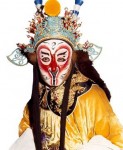 performance starts to see how performers do their makeup. Luciano Pararotti, the great tenor of international fame, once had a Peking Opera actor paint on his face the makeup of Xiang Yu, a valiant ancient warrior portrayed in numerous Peking Opera plays.
performance starts to see how performers do their makeup. Luciano Pararotti, the great tenor of international fame, once had a Peking Opera actor paint on his face the makeup of Xiang Yu, a valiant ancient warrior portrayed in numerous Peking Opera plays.
The facial makeup is a unique way of portrayal in the traditional Chinese theater. Makeup types number thousands, and different types have different meanings. At an early date, most faces were painted black, red and white. As plays increase in number, opera artists used more colors and lines to paint the faces of characters, to either exaggerate or differentiate, according to Weng Ouhong, a researcher of the classic Chinese theater. They drew inspirations from classical novels, which portray characters as having “a face as red as a red jujube,” “a face the color of dark gold,” ”a ginger-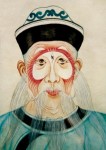 yellow face,” “a green face with yellow beard,” “a leopard-shaped head with round eyes,” “a lion’s nose” or “broom-shaped eyebrows.”
yellow face,” “a green face with yellow beard,” “a leopard-shaped head with round eyes,” “a lion’s nose” or “broom-shaped eyebrows.”
Color patterns painted on the faces of opera characters are called lianpu, or facial makeup. When a character’s face needs to be exaggerated, a makeup type is painted. The most common facial makeup types are jing and chou. Jing is an actor with a painted face and chou is the role of a clown. For different roles with different makeup types, ways of color application and painting are different. For some makeup types such as one for a hero, color is applied to the face with hand; no paintbrush is used. For most types of warrior, colors mixed with oil are painted on the face, and meticulous attention is paid to shades of coloring, the size of eye sockets and the shape of the eyebrows. For treacherous court officials, the face is painted white, with the eyebrows and eye corners slightly accentuated and a couple of “treachery” lines added.
A facial makeup type points to the personality of a particular character type. A red face indicates uprightness and loyalty, a black face a rough and forthright character, a blue face bravery and pride, a white face treachery and cunning, and a face with a white patch a fawning and base character. To show kinship, father and son can have faces of the same color with similar patterns. To show identity, a face with a dignified pattern belongs to a loyal official or a loving son, a blue-and-green face to an outlaw hero, a face with kidney-shaped eyes and wooden-club-shaped eyebrows to a monk, a face with sharp eye corners and a small mouth to a court eunuch, and a face with a white patch to a minor character.
Facial makeup can also allow actors to expand the scope of acting. If animals are to be portrayed, there is no need to have real horses and cattle on the stage. For example, in the play titled the Jinshan Temple, there is an army of shrimps and crabs fighting an evil character. They are played by performers with faces painted with a shrimp or crab. With novel patterns, bright colors, standard or wry contours and thick or thin lines, facial makeup can arouse the interest of the audience and add interest to Peking Opera performances.
Jing characters are also called “painted faces.” As the name suggests, they wear faces with complicated patterns, and different jing characters have different painted faces. But the clown, or chou, in Peking Opera was the earliest character to have a painted face. Compared with jing characters, clowns have a simple facial makeup, though it is not limited to a white patch on the face. Clowns usually make a greater impression on the audience than jing characters.
After years of development, there have been established rules on how to 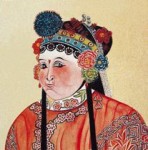 paint faces and what different facial patterns represent. Types of facial makeup reveal the Chinese people’s evaluation of historical figures. For example, Cao Cao, a Han Dynasty prime minister, and Yan Song, a Ming Dynasty prime minister, wear a white face, indicating they are treacherous and cunning; Guan Yu, a general of the Three Kingdoms period, has a dignified red face, showing he was a loyal person; and Judge Bao wears a black face, meaning he was impartial and incorruptible as a judge.
paint faces and what different facial patterns represent. Types of facial makeup reveal the Chinese people’s evaluation of historical figures. For example, Cao Cao, a Han Dynasty prime minister, and Yan Song, a Ming Dynasty prime minister, wear a white face, indicating they are treacherous and cunning; Guan Yu, a general of the Three Kingdoms period, has a dignified red face, showing he was a loyal person; and Judge Bao wears a black face, meaning he was impartial and incorruptible as a judge.
Knowledge of facial makeup can help audiences understand the plot of Peking Opera. While facial makeup develops in operatic performance, masks have not been banished. In propitious and mythological plays, characters use masks called, for example, “god of wealth mask” and “god of thunder mask.” In some plays, facial makeup and masks appear on the stage at the same time.
For foreigners, the facial makeup in Peking Opera is quite mysterious. As a symbol of Peking Opera culture, facial patterns appear on an increasing  number of handicraft articles that hold a strong appeal to people. Even in fashion design, the Peking Opera makeup has become a chic factor shown on the T-shaped runway. Together with clothes, it has entered the life of people today.
number of handicraft articles that hold a strong appeal to people. Even in fashion design, the Peking Opera makeup has become a chic factor shown on the T-shaped runway. Together with clothes, it has entered the life of people today.
Foods from Afar
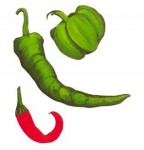 According to statistics, seventy to eighty thousand species of edible plants exist on the earth, among which are about 150 species that can be grown in large quantities. However, only 20 species of those are being used widely in farming today, but already make up for 90% of the world’s total grain production. Domesticated animals and plant species are essentially the basis of global agricultural production. The fishing industry, which relies on wild animals as basic provision, outputs nearly 100 million tons of food annually for global consumption. Just as other countries of the world, the trade and spreading of foods, edible plants and animal species in China have been a nonstop process since ancient times. Not only did this broaden the range of the Chinese’s food supply and made Chinese cuisines even more full of tasty dishes, but has also caused changes in Chinese dietary habits and put more life and variety into Chinese food culture.
According to statistics, seventy to eighty thousand species of edible plants exist on the earth, among which are about 150 species that can be grown in large quantities. However, only 20 species of those are being used widely in farming today, but already make up for 90% of the world’s total grain production. Domesticated animals and plant species are essentially the basis of global agricultural production. The fishing industry, which relies on wild animals as basic provision, outputs nearly 100 million tons of food annually for global consumption. Just as other countries of the world, the trade and spreading of foods, edible plants and animal species in China have been a nonstop process since ancient times. Not only did this broaden the range of the Chinese’s food supply and made Chinese cuisines even more full of tasty dishes, but has also caused changes in Chinese dietary habits and put more life and variety into Chinese food culture.
Besides a small number of food species that were introduced to China by pre-Qin Dynasty period, a larger scaled food trading and spreading happened over two thousand years ago during the tremendously prosperous and powerful West Han Dynasty. Grape, pomegranate, sesame, lima bean, walnut, cucumber, watermelon, muskmelon, carrot, fennel, celery, Chinese parsley (coriander) and other food species, which had its origins in the Xinjiang (Uygur) region of China or West and Central Asia, made their way into central Han Chinese territory by way of the Silk Road. And it was from that time, the Chinese and foreign cultures experienced more communication as the days went by. Many foods that were not indigenous to China began to appear on Chinese dining tables.
The corn, which has its roots in the Americas, was introduced to the Orient through Europe, Africa and West Asia. The potato, a cross between principal food and a vegetable, came to China via the southeast coast of China; at first it was only planted in Fujian and Zhejiang regions. Sunflower seeds made its way into China from America during the 17th century; 200 years later, cooking oil was extracted from it, making the Chinese line-up of oils even more complete. The mung bean (gram), of the pod-bearing crops, has its roots in India, and was brought to China in the Northern Song Dynasty (960-1127 A.D.). Spinach, a kind of vegetable, came by way of Persia during the reign of Emperor Taizong (627-649 A.D.) of the Tang Dynasty. The eggplant, which was first found in India, along with the teachings of Buddhism, spread into China in the Northern and Southern Dynasties ( 4 2 0 – 5 8 9 A.D.) . Many crops with unmistakably Chinese origins such as peanut, garlic, tomato, balsam pear, pea and other food types were replaced by premium foreign species.
Early fruits introduced to China mostly came from West Asia (e.g. grapes), Central Asia ( e.g. early apples), the Mediterranean (e.g. olives), India (e.g. oranges), and Southeast Asia (e.g. coconuts, bananas). Other fruits such as pineapple, tomato, persimmon, strawberry, apple, durian, grapefruit and more, which have become the principal fruits for the Chinese, were imported from Southeast Asia, the Americas, or Australia/ Oceania in modern times.
Hot pepper, already a popular type of spice for Chinese dishes, has only had about 300 years of history with the Chinese. Historical records show that hot peppers came to China by sea from Peru and Mexico during the late-Ming Dynasty (1368-1644 A.D.). Sugar, the main source of sweetness in cooking, saw its production in China after Emperor Taizong’s ambassadors to Central Asia during the Tang Dynasty, learned sugar-making skills. What the Chinese see as high-class food, namely the shark’s fin and bird’s nest, were introduced to China from Southeast Asia in the 14th century. Starting in the Qing Dynasty (1616-1911 A.D.), they have become lavish foods for the wealthy only. With the widespread influence of Western cultures, exotic beverages such as coffee, soda, fruit juices as well as all kinds of alcohol drinks are no longer a rarity in Chinese eyes.
In terms of dishes, the earliest foreign recipes were introduced to China in the Tang Dynasty. As frequent trade between China and other countries flourished, the Arabs, who brought their Muslim foods, made great contributions to diversifying the Chinese dietary customs and adding to the already plentiful selection of Chinese culinary techniques. In near-modern times, Western foods appeared in China. Not only can all types of Western restaurants be found around many commercial ports, Chinese and Western food even fused together to create a new style of gourmet technique. This is most exemplified in the Yue (Cantonese) style of Chinese foods.
In recent years, as Sino-foreign economic and cultural exchange became more intimate, the importation of premium animal and plant species from foreign countries has already become a crucial part of the Chinese import business. More and more foreign foods have found their ways into the home of common Chinese families. However, the Chinese government, just as governments of other countries, is beginning to see the large quantities of imported, or invading foreign species as a threat to domestic biological varieties. Laws and policies on protecting national ecological security have been drafted and implemented.
Life and Propagation – an All-time Theme
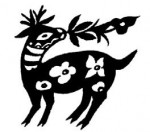 Folk social customs are the carriers of Chinese folk art which has numerous categories and a variety of art forms. However, despite all the categories and forms on the outside, the core lies within the basic cultural consciousness of the people and the original Chinese philosophy.
Folk social customs are the carriers of Chinese folk art which has numerous categories and a variety of art forms. However, despite all the categories and forms on the outside, the core lies within the basic cultural consciousness of the people and the original Chinese philosophy.
To live and to continue life through propagation are the two instinctive desires of humans. From birth, a person’s first instinct is to survive, then to live a long life. However, life and death are immutable laws of nature. Therefore, they turned to seek perpetuity after life, praying for longevity for the living, and perpetuity for the dead. Since the eternity of life could only be achieved through propagation, producing children and grandchildren to pass on life from generation to generation became the ultimate goal. Thus, human perception of propagation was the same as their perception of life itself. Propagation of people and harvesting of crops were deemed as good fortune. In this way, fortune and longevity became the basic cultural consciousness of the people, which was also the main theme of folk art.
Chinese folk art and Chinese philosophy are unified in the belief that yin-yang produces all living things on earth and all living things stay alive through propagation. Originated in Chinese primitive society, this was the philosophical explanation of human’s perception of life and propagation. Chinese ancestor’s philosophical conclusion was to “look at oneself up close and other creatures from afar.” Observing one’s own life in this manner would lead to the understanding of other living things on earth. This conclusion had been the essential cultural understanding of the primitive art to the folk art of the nation.
With the coming of property ownership and intellectual development, thesociety began to be divided into the governing class and the governed. Class society was established. The majority of material and intellectual valuables were disproportionately accumulated in the upper classes where they created a more affluent life style. To get a better life, the concept of profit came into the larger community. The previous cultural concept of “fortune and longevity” expanded into “fortune, longevity, and wealth.” Together they formed the secular culture of folk art. This was especially true in areas that were more culturally and economically developed. Folk art with themes of fortune, longevity, and wealth became widespread. In areas more culturally enclosed with undeveloped communications and economy, the themes were still luck and longevity symbolized by life and propagation. Folk art paper-cut of “Lotus bearing seeds” implied life and propagation in the rural area of northern Shaanxi. On the other hand, in Tianjin where the economy was more developed and transportation had become convenient, New Year woodcut pictures became “Lotus bearing precious seeds” and “Five sons obtaining official promotion.” To become official was to be in the position to obtain wealth.
Transitioning from a natural farming economy to a commodity economy meant that there was a need for profitable commodities. With this change money became important. This evolution in the society brought about a change in the folk art. The “Tree of life” turned into a “Tree that shed coins” or a “Treasure bowl.” The goal in life was no longer to gain basic survival. Life and propagation gradually faded and was replaced by symbols denoting a happy life and good fortune. For example, by combining two items such as a halberd (symbolizing favorable circumstances) and jade (symbolizing fulfillment of ones wishes) auspicious good fortune would replace the original concept of perpetual life. Having many children was symbolized with lotus in a vase. Another example to have every wish granted was expressed by combining two persimmons with jade. The persimmons were symbolic of having everything. The life view changed from simple propagation to living comfortably with extras. Looking at Chinese folk art through different times is like separating cultural layers at an archaeological site. Every shard carries the trace of the historical culture of its time.
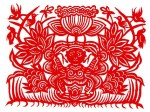 From primitive society to the present day, the view of yin-yang and perpetual life has permeated all aspects of the social life and national culture of Chinese society. Chinese folk art reflects all of the basic philosophical concepts of the society. From my research of Chinese and world archaeological cultures, I have concluded that yin-yang and perpetual life view were the two key factors in opening up the database of Chinese cultural genes. In Western cultures, everything evolves around perpetual life. Whereas yin-yang was regarded as the essence of Chinese cosmic ontology, it was regarded as part of dialectical methodology in the west.
From primitive society to the present day, the view of yin-yang and perpetual life has permeated all aspects of the social life and national culture of Chinese society. Chinese folk art reflects all of the basic philosophical concepts of the society. From my research of Chinese and world archaeological cultures, I have concluded that yin-yang and perpetual life view were the two key factors in opening up the database of Chinese cultural genes. In Western cultures, everything evolves around perpetual life. Whereas yin-yang was regarded as the essence of Chinese cosmic ontology, it was regarded as part of dialectical methodology in the west.